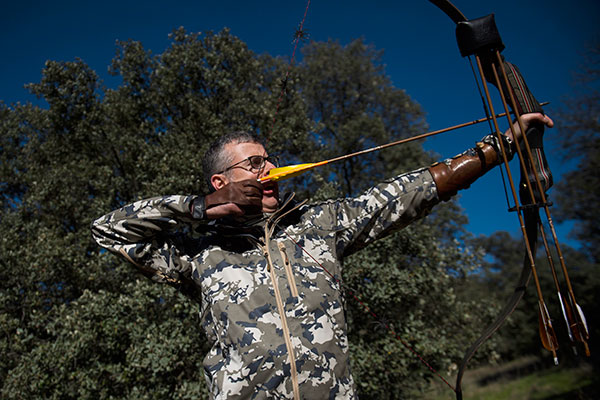Archers at sharp end of boar cull
Authorities resort to traditional weapons to eliminate wild pigs
 |
|
Hunter Javier Sintes trains with his bow on the outskirts of San Agustin del Guadalix near Madrid. [PIERRE-PHILIPPE MARCOU/AGENCE FRANCE-PRESSE] |
It's a scene straight out of medieval times set in modern-day Madrid: an archer dressed in camouflage gear, stationed in a tree at night, waiting for the kill.
For five years, the authorities in the region have resorted to this unusual technique to cull wild boar that encroach on towns, relying on 55 volunteer bow hunters to eliminate pigs that take too much of a liking to urban life.
"The bow is a silent weapon and people who use it act in a silent way too, so we don't disturb the environment or people," explains Emilio de la Cruz, a 45-year-old business owner and keen hunter who volunteers for this form of population control.
The method is just one used to try and curb the proliferation of wild boar going further and further into populated areas, causing agricultural damage and road accidents.
From an estimated 25,000 to 35,000 five years ago, the number of boars in Madrid has risen to around 30,000 to 40,000, environmental authorities say.
But the method is not without its controversy, with environmentalists arguing that the animal can suffer an agonizing death if the archer takes a bad shot.
In some countries such as Britain, bow hunting is banned altogether.
De la Cruz maintains that he and his hunting companions are all experienced, trained to shoot the arrow through the boar's vital organs in a quick, clean kill.
Standing at a training ground in the rolling hills outside Madrid, a boar-shaped target in the background, he said the archers go out 100 to 150 times a year at the request of city or town halls in the region.
In five years, they have killed 201 boars and close to 60 wild goats that have proliferated in La Pedriza, a mountain range near the Spanish capital popular with hikers and climbers.
When asked to intervene, the hunters first study the zone to analyze the boars' movements, set up shop in trees or other elevated places at night, wait-sometimes for hours-and take aim.
They hunt in parks, golf courses or any area close to a town or city where boars have been spotted roaming free, giving the odd jogger a shock.
The problem of wild boars running riot in populated zones affects countries the world over, in large part due to rampant urbanization that has gobbled up their habitat.
As an example, a wild boar in Hong Kong led police on a chase last month after it wandered onto the apron of the international airport.
"They've grown used to the presence of people, to eating in rubbish bins and some people even give them food," says Felipe Ruza, deputy head of environmental conservation for the Madrid region.
"This causes problems because they invade gardens, cause traffic accidents and they can even attack people if there is a sow with her piglets."
Theo Oberhuber, of environmental group Ecologists in Action, would rather see a sterilization program instead of the cull.
He points to a trial in Spain's Catalonia that involves putting contraceptives in boars' food.
"This could be an unaggressive method that doesn't cause death and progressively reduces the number of boars," he said.



















